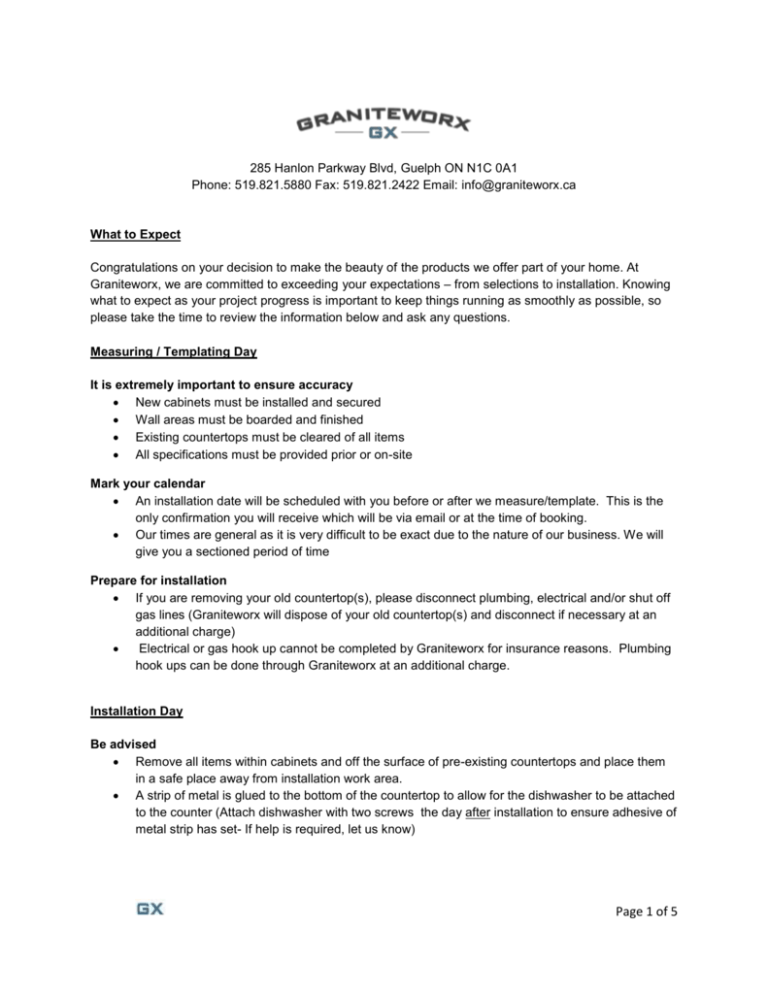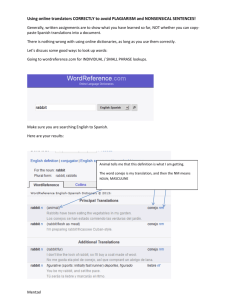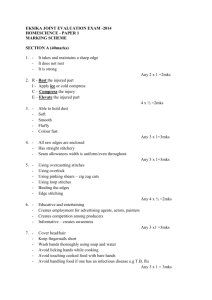285 Hanlon Parkway Blvd, Guelph ON N1C 0A1 Phone: 519.821
advertisement

285 Hanlon Parkway Blvd, Guelph ON N1C 0A1 Phone: 519.821.5880 Fax: 519.821.2422 Email: info@graniteworx.ca What to Expect Congratulations on your decision to make the beauty of the products we offer part of your home. At Graniteworx, we are committed to exceeding your expectations – from selections to installation. Knowing what to expect as your project progress is important to keep things running as smoothly as possible, so please take the time to review the information below and ask any questions. Measuring / Templating Day It is extremely important to ensure accuracy New cabinets must be installed and secured Wall areas must be boarded and finished Existing countertops must be cleared of all items All specifications must be provided prior or on-site Mark your calendar An installation date will be scheduled with you before or after we measure/template. This is the only confirmation you will receive which will be via email or at the time of booking. Our times are general as it is very difficult to be exact due to the nature of our business. We will give you a sectioned period of time Prepare for installation If you are removing your old countertop(s), please disconnect plumbing, electrical and/or shut off gas lines (Graniteworx will dispose of your old countertop(s) and disconnect if necessary at an additional charge) Electrical or gas hook up cannot be completed by Graniteworx for insurance reasons. Plumbing hook ups can be done through Graniteworx at an additional charge. Installation Day Be advised Remove all items within cabinets and off the surface of pre-existing countertops and place them in a safe place away from installation work area. A strip of metal is glued to the bottom of the countertop to allow for the dishwasher to be attached to the counter (Attach dishwasher with two screws the day after installation to ensure adhesive of metal strip has set- If help is required, let us know) Page 1 of 5 Silicone and paintable caulking will be used by our installer to seal any gaps after the completion of your countertop. Allow sinks to set overnight before having your plumber connect your drain and taps. Unless Graniteworx will be connecting your plumbing. Items can be placed back inside cabinets as soon as installation is complete The impact of installation on the rest of your home is important to us All efforts, within reason, will be made to contain dust generated by the installation process Precautions will be taken to protect floors and walls, however, if damage occurs we will be responsible for repairs as needed but only after a Graniteworx representative can inspect the damage and a suitable solution can be agreed upon by all parties involved Removal and reinstallation of valances, receptacles, tile backsplash and lighting will be completed for full-height backsplash as required unless otherwise noted. Information and Care Guide Granite is the most popular natural stone and countertop material due to its versatility and superior performance characteristics. It is one of the hardest and strongest materials in nature, originating from the earth’s core as liquid magma. Extreme heat and pressure forged the quartz, mica, feldspar and other minerals into a very dense structure millions of years ago. Over time, additional heat and pressure created the fascinating combinations of colour and pattern creating a surface that is truly unique. Surface patterns typically will have a flecked or pebbled appearance which can vary in size, shape and density of the pattern depending on the particular mix of quartz, crystals and minerals that make up the stone. The pattern can be highly structured offering a uniform appearance over the entire countertop or the pattern may change continually, without repetition, called “movement”. Various textures are also available such as polished, honed and antiqued finishes. Cleaning: Clean with a soapy cloth, using mild dish soap and hot water only. Some stones, especially darker colours, require surface towel drying after washing to avoid showing streaks. The use of vinegar, ammonia, lemon, orange, household chemicals, acid or solvents may damage the surface or granite over time. To remove stubborn sticky materials, like glue, or any product that has hardened, use a razor blade tip or 000 fine- grade steel wool. If staining occurs, there are ways to pull the stain out of the stone. Please call the office for more details. Sealing: Use a wipe on, wipe off procedure, similar to how you might clean any countertop on a daily basis. Frequency of granite sealer application for your particular stone is dependent on the density. It is time to reseal your countertop if: water sitting on your countertop makes that area look slightly darker showing the water is penetrating into the stone. This spot will dissipate after a few hours or less. All countertops will get a coat of sealer before leaving the shop, but some stones will require a few extra coats right after installation. Don’t be alarmed if some of the lighter coloured stones require this extra application. The sealer is available to purchase at our store. The DuPont 15 year stain warranty protection is also available. See Graniteworx for more detail. Scratches/chips: Granite is resistant to cracks, chips, scratches & stains. However, like most materials, excessive force and/or pressure from objects can damage the surface. Page 2 of 5 Heat: Hot pots can be placed directly on granite from the stove without any problems. However, we do not suggest placing metal pans that you have been cooking with hot oil directly onto the countertop, as the metal of the pan may be beyond the thermal breaking point of certain stones. Marble is a delicate surface & should be treated with great care. It is softer and more porous than granite, which makes it susceptible to stains, scratching and etching. Marble is a crystallized limestone and therefore can be polished to a mirror-finish bringing out a vibrant depth in color. Polished marble is only recommended for counter tops that are lightly used such as: vanities, furniture piece, etc., but NOT for kitchen countertops or a wet bar. Marble is made of calcium carbonate, which is reactive with acids (fruit juice, soda, coffee, alcohol, salad dressing, etc.) and will “etch” upon contact destroying the polish and leaving a dull, light spot. Unfortunately sealing does not prevent etching. Professional restoration can remove etching and restore polish to surfaces if badly damaged. Over the years the marble will begin to age or patina through absorption of stains, a film or discoloration may occur and the stone will reflect the essential character of your home. Cleaning: Clean with a cloth and hot water only. Buff dry with a cotton cloth or chamois. Using a mild soap occasionally for cleaning marble won’t harm the stone, but consistent use will dull the surface. Hard water will leave calcium deposits on the surface which can be cleaned with a special cleaner available at Graniteworx. DO NOT use vinegar, ammonia, lemon, orange, household chemicals, acids or solvents for cleaning marble. Care is also recommended when using these products near the stone. Sealing: Products are available at Graniteworx and directions for sealing marble are the same as explained for granite. Please note: Marble requires more frequent sealing than granite. Quartz is made of approximately 93% natural quartz aggregates and a small amount of pigments and polyester resins which form the balance of the material. It has the strength and durability of the strongest granite, but is a non-porous surface. Cleaning: Simply wipe with warm water and soap, using a damp cloth or paper towel. If needed, use nonabrasive, household cleaners such as Oxy-Gel Spray. DO NOT use Vim Cream, Mr. Clean Magic Eraser or abrasive pads. To remove adhered material such as: food or nail polish, first scrape away the excess material with a plastic putty knife & then clean the surface with a damp cloth to remove marks or any residual dirt. Sealing: The high gloss finish and non-porous nature provide maximum resistance to staining – no sealing is required, but it is not warranted against stains. Please refer to the manufactures warranty. Scratches/chips: Quartz is resistant to cracks, chips, scratches & stains. However, like most materials, excessive force and/or pressure from objects can damage the surface. Heat: Quartz is not affected by heat below 400 degrees Fahrenheit but it is not advised to place hot pans directly on the material. Trivets are recommended when using cooking units such as electric frying pans, crock pots or roaster ovens. Page 3 of 5 Butcher Block Cleaning: Cleans up easily with mild soap and water. Go over surface again with clean warm water. Take dry cloth and go over all surfaces to dry thoroughly. Do not use any abrasive house hold cleaner or vinegar. Sealing: The natural wood surface is protected by oil, which is actually absorbed into the fibers. Oiled tops should be re oiled anywhere from every 2-4 weeks depending upon use. The more consistently wet the area is, the more you should use it. We recommend using the Boos Mystery oil which is a combination of pure mineral oil and raw linseed oil. This will hold protect the wood from the water absorbing. If you are finding it is still really dry you may use Boos Block Board Cream which will add moisture. This is an unbleached beeswax and mineral oil that will leave a silky wax barrier and lock moisture in. Scratches/chips: If you wish to remove cut marks, just sand off the top with the grain and re-oil. Information and Care Guide for Sinks Stainless steel sinks with a chrome nickel content of 18/10 and a gauge of 18 are recommended for home use. Chrome increases hardness and wear resistance. Nickel increases strength and improves shock resistance. A thicker gauge steel (thickness is an inverse measurement- 20 gauge is thinner than 18) will maintain water temperature longer and has more sound deadening qualities. Scratches/Chips: Minor scratches may be blended into the sink by lightly rubbing a scrub pad in the direction of the finished grain. Cleaning: Water and vinegar mixed in a solution may be used to remove mineral deposits that have built up in the surface. To prevent water spots, towels dry your sink after each use. Stainless steel is a material that does not rust, however, iron particles that do rust will bond to its surface. A steel polish cleaner may be used to remove these spots. Granite composite sinks are chip and scratch resistant and have a heat rating of up to 280 degrees Celsius which means boiling hot water may be poured into your sink but a hot pot may burn the surface. Scratches/Chips A metal pan or pot may leave a mark but this is not a scratch. To remove use a scrub pad and soap Cleaning: Avoid highly abrasive cleansers. A bleach-water solution (50/50) can be used for stubborn food stains such as grease and oil rings. Fill the sink with the bleach and water solution above the stain ring line and allow to sit for at least ½ an hour before cleaning with a dish detergent and rinsing with water. Cast iron sinks feature a thick enamel coating in a variety of colors. Fired at temperatures much higher than possible with enameled steel products, the cast iron surface is “fired polished” to obtain its vivid color and deep gloss. Its density provides outstanding heat retention properties, so water stays warm longer. Scratches/chips: the thickness makes it durable and resistant against most damage including scratching but also against acids and denting. Fine Scratches will occur but cork can remove metal scratches. Page 4 of 5 Cleaning: Rinse thoroughly and use a soft cloth to wipe the product dry after each use. In the rare occurrence of stubborn stains, use abrasive cleaners sparingly or recommended product to clean Cast Iron. See Graniteworx showroom. Do not use steel wool, wire brushes or abrasive sponge pad. Porcelain or vitreous china sinks have enamel which is a glass surfaced fused to a metal base. Scratches/chips: The surface is very hard but can be chipped by hard blows. Cleaning: Wash with detergent and warm water. A solution of baking soda, in warm water may also remove soap scum and soil. Household or bathroom cleaners may be used, as well as, chlorine or hydrogen peroxide bleach to remove stains. Do not use these bleaches full strength or let them remain on the surface for more than a few seconds. Rinse the surface thoroughly after cleaning. Copper finishes develops its own rich warm patina as it is used and ages. You’ll notice the rich reddish color varies from sink to sink and may, in fact, present dark spots or streaks due to the nature of the sink and the finish. General Care and Cleaning: Care is simple and easy. Under normal use, copper will develop its own warm and rich patina. To preserve that look, use only a gentle mild soap and water to clean the surface. No other cleaners are needed. If a bright shiny “new Copper” look is desired, use non-abrasive copper cleaners and follow directions carefully. Whichever look you desire, it is important to keep the copper sink basin and drain dry to avoid water spotting or pitting. Wipe the basin periodically with a soft dry cloth. To maintain luster and improve water runoff, use Renaissance Wax or a similar product. Cleansers or Corrosive Substances: NEVER use abrasive materials or harsh chemicals on an copper sink. They will scratch the surface and finish of your sink. NEVER use chlorine bleach or cleansers, concentrated vinegar, abrasive cleaners, or any other harsh chemicals since these may damage the sink finish. Acidic Foods: NEVER leave acidic foods such as oranges or lemons, tomatoes, tea, etc. on your sink. If you do, you may experience shiny spots. If spotting does occur, we recommend cleaning the sink with soap and water and then waiting for the finish to recover to its natural patina. As the sink ages, the spots will blend with the surrounding areas, returning the finish to the rich natural patina you love. Artisan Fleur-de-lis Collection with LustreGarde™ finish is real metal and is considered to be a living finish. As the metal ages, it will take on its own natural look. To avoid damaging the finish and to protect the natural beauty, please follow these instructions carefully. General Care and Cleaning: Never use abrasive or citric acid cleaners (such as Ajax, Barkeepers Friend) or soft scrub cleaners and pads. Harsh chemicals may damage the finish. Mineral Oil or nonabrasive GoJo hand cleaner may be used to maintain oil rubbed appearance and minimize spotting. EXTRA fine steel wool along with GoJo hand cleaner may be used to remove Verdi (green patina) or to lighten antique finishes. Gently rub the sink until the finish is achieved, rinse, and buff with a soft cloth. It is not unusual for some tarnish to appear on cloth after cleaning. Page 5 of 5





